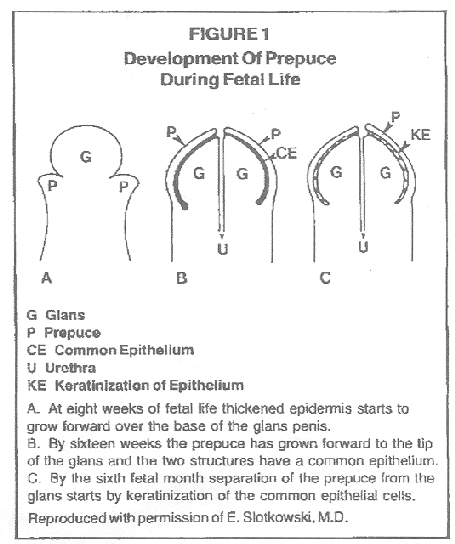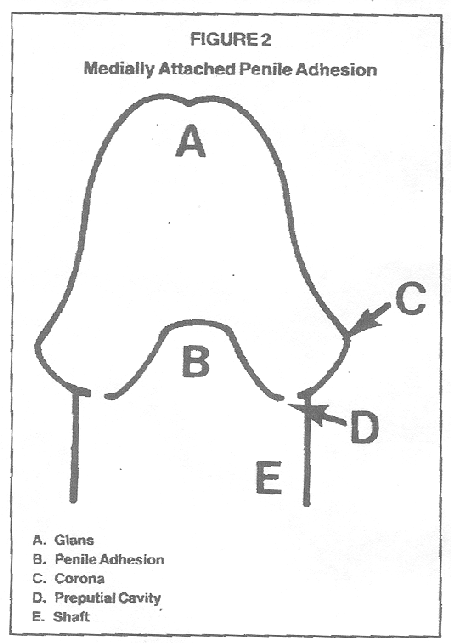
Nurse Practitioner, Volume 5, Issue 9: Pages 22-24, May 1984.
A penile or prepuce adhesion can occur after a circumcision if the remaining skin is not retracted after the circumcision has healed. When a circumcision is done, tissue which would normally be intact is split. Unless proper care is taken, the epithelium of the inner prepuce at the point where the foreskin was removed can reattach to the epithelium of the glans. The result of this is a penile adhesion. Usually the adhesions can be released by simple retraction. Sometimes, however, the fusion is so complete that simple retraction will not work, and the child must be referred to a urologist. Another problem is that smegma or bacteria can collect under the adhesion if it covers the preputial cavity and cause infection. Professionals must look for this problem, and parents must be taught how to care for the normal circumcised penis so that penile adhesions do not develop. This article discusses the formation and identification of penile adhesions, the process by which adhesions can be released, when a referral to a urologist is necessary and the proper care for the circumcised penis.
The decision of whether or not to circumcise a male infant is controversial. The Committee on Fetus and Newborn of the American Academy of Pediatrics issued a statement in 1971 that there were no valid medical indications for circumcision in the neonatal period. The Ad Hoc Task Force on Circumcision of the American Academy of Pediatrics reaffirmed that statement in 1975.1 The purpose of this article is not to argue for or against circumcision, but to discuss the care of the penis after circumcision and a complication which can arise -- the penile or prepuce adhesion.

When a circumcision is done, regardless of the method used, tissue which would normally be intact is split "much like skinning a squirrel."2 This tissue develops during embryonic life when the epithelial skin of the glans and the inner epithelium of the prepuce (foreskin) fuse. By the sixth month of gestation, these two stratified squamous layers begin to separate from each other by the process of keratinization (development of the horny layer) or desquamation (scaling).3 This process produces areas of separation which eventually all join to form a complete separation. (See Figure 1.)3 This separation usually occurs later in the child's life. At birth, only four percent of newborn males have completed this process and have fully retractable foreskins; by 6 months, 20 percent; by 3 years, 90 percent; and by 17 years, 99 percent.4 A circumcision, however, separates this epithelium prematurely, and unless proper care is taken, the epithelium of the inner prepuce at the point where the foreskin was removed (i.e. the top of the shaft) can reattach to the epithelium of the glans. The result of this is a penile adhesion. The skin that can reattach is confusingly referred to in the medical literature as foreskin. In this article it will be referred to as the shaft skin. A diagram of a penile adhesion can be seen in Figure 2.

Penile adhesions can be found in many forms. Some can be attached laterally, medially, circumferentially, as a bridge of tissue from the shaft to the glans, or as a combination of all of the above. Adhesions can also be found at the preputial cavity where the mucosal folds join.5 The preputial cavity is the space directly below the corona where the shaft meets the glans. (See Figure 2) "When adhesions are present proximal to the corona, the preputial cavity may be obliterated. This type may be easily overlooked if the foreskin is retracted, exposing just the glans and without unfolding the entire preputial cavity."6
A penile adhesion can cause problems. The major one is that it can completely fuse, causing total reattachment of the shaft skin, and require surgical release or "recircumcision." Usually the adhesions can be released by simple retraction, done either by the practitioner or the parents. Sometimes, however, the fusion is so complete that simple retraction will not work, and the child must be referred to a urologist. Another problem is that smegma or bacteria can accumulate under the adhesion if it covers the preputial cavity and can cause infection.7 Also, if a bridge-like adhesion is present, it can produce a tethering of the erect penis which can cause pain, penile curvature or both.7-8
To prevent the occurrence of penile adhesions, nurses and parents must be shown the proper technique of caring for the penis following a circumcision. Most nursing textbooks discuss the procedure and the initial care following a circumcision, which involves observation for bleeding and the application of Vaseline gauze or a lubricant and sterile gauze for 24 to 48 hours but do not discuss later retraction of the shaft skin.9-13 but usually this is all that they are taught. The penis looks different immediately following a circumcision than it does a few days later (at which time most babies are home from the hospital). With the swelling that occurs after a circumcision, the natural appearance of the shaft skin cannot be appreciated. The skin must heal after the circumcision and should not be retracted for approximately 10 to 14 days. However, the mother and the father must learn to pull back the shaft skin every day after the circumcision is healed so that the corona is free from any adherent skin. Another reason to retract the skin is to clean around the base of the glans, being certain to remove smegma and any other debris. Then the shaft skin should be returned to its original position, or a paraphimosis (constriction of the penis by the shaft skin) couldoccur.
The technique of retraction can be taught to the parents while they are in the hospital. When the shaft skin is fully retracted, the glans should look like the top of a mushroom, with the corona and preputial cavity plainly visible. Oftentimes the edge of the corona has a purplish hue, and the parents can be told to look for this. Even though they cannot practice on their own child immediately following a circumcision, parents can practice the technique by any means the nurse finds helpful. One way might be to use two finger cots, one with the bottom removed and placed low on the finger, and the other rolled up and placed on the tip of that same finger. The lower cot can represent the shaft skin and the top can represent the glans and the corona. (To the authors knowledge, a practical model is not available.)
The author conducted an informal survey in her clinical practice to discover the incidence of penile adhesions. Of the 150 males seen over the past year at their first visit (to the author), 23 or 15 percent, of the circumcised males had penile adhesions and 5, or three percent, had to have surgical correction. Since on statistics could be found in the literature on the occurrence of penile adhesions in the United States, there is no way to tell how this compares to nationalnorms.
When the mothers (who were the ones bringing the children to the clinic) were shown the adhesions, many were unaware that the adhesions were present. Many mothers did not know that they were supposed to retract the shaft skin. Others did not know how far the shaft skin could be retracted, were afraid of hurting their child or did not like to touch their child's penis. This lack of knowledge on the parents' part illustrates the importance of proper teaching by professionals to mothers and fathers while in the hospital and in the ambulatory setting. Subsequent to the discovering ofthe adhesions, the parents were taught how to release them.
When an adhesion is found, it can be released by a process similar to smoothing out air bubbles under adhesive paper or tape; however with an adhesion, one is pulling in opposite directions from a central point. The penis is gently held in both hands with one thumb at the point of the adhesion and other on the glans just next to it. The index fingers are placed under the thumbs and penis, supporting the penis. The thumbs are simultaneously brought outward from the adhesion, putting slight pressure on the skin. The thumb on the glans offers resistance to the pulling of the thumb on the adhesion. If the skin is loosely attached, it will separate easily. An excellent solution is to have the parents slowly release the adhesion by gently retracting the skin daily after the bath, when the skin is softened. Parents can be shown how to do this in the clinic and then be asked to demonstrate it for the nurse. This way it is evident if the parent has an aversion to touching the penis and if an honest attempt will be made to release the adhesion. One mother did successfully release here son's adhesion, but she said that she hated doing it. If the parent cannot release the adhesion after two to your weeks, then the practitioner should attempt to do so. If the practitioner is unsuccessful, the child should be referred to a urologist.
A penile adhesion is an unnecessary and preventable complication in the circumcised male child. Since approximately 1.5 million males are circumcised every year in the United States according to the Hospital Record Study of the Commission on Professional and Hospital Activities,3 the possibility for penile adhesions is great. Practitioners, nurses and physicians must carefully examine male children for this problem and be adamant in teaching parents how to prevent or remedy this condition. With proper instruction,this problem can easily be prevented.
Sanchez, R.A.,M.D.: Personal Communcation, January 5, 1983.<(p>
About the author: Katherine A. Gracely-Kilgore, R.N., M.S.N., C.P.N.P., is currently practicing at the Albany Medical Center Hospital, Albany, N.Y. Research for this article, however, was done while she was employed by Grant Hospital, Chicago, Ill. Gracely-Kilgore is a fellow and past treasurer of the Maryland-Chesapeake chapter of the National Association of Pediatric Nurse Associaties/Practitioners (NAPNAP). Her special interests include parenting groups, child rearing and behavioralpediatrics.
The Circumcision Information and Resource Pages are a not-for-profit educational resource and library. IntactiWiki hosts this website but is not responsible for the content of this site. CIRP makes documents available without charge, for informational purposes only. The contents of this site are not intended to replace the professional medical or legal advice of a licensed practitioner.
© CIRP.org 1996-2024 | Please visit our sponsor and host: IntactiWiki.